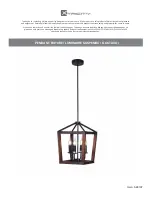
TAL 114 (L) Rev. 4 - 10090982
DESCRIPTION
DESCRIPTION
The OptimAir Mask-Mounted Powered
Air-Purifying Respirator (PAPR) from
MSA is certified by the National
Institute for Occupational Safety and
Health (NIOSH) as an air-purifying
device designed only for use in atmos-
pheres
NOT
immediately dangerous to
life or health (IDLH).
The OptimAir Mask-Mounted PAPR is
used with the Facepiece, which is
available in small, medium or large
sizes. If needed, Advantage
®
4100,
Ultravue
®
and Ultra Elite
®
Facepieces
may be equipped with an integral
welder’s lens or clip-on welder’s
adapter (only used with Ultravue
Facepieces). See Accessories/Spare
Parts.
The motor-blower and replaceable
high-efficiency filter are worn as an
assembly attached to the facepiece.
The rechargeable battery pack is worn
on the support belt. A power cable
connects the belt-mounted battery
pack to the motor-blower on the face-
piece. A battery charger is supplied
with the respirator.
PRINCIPLE OF OPERATION
The motor-blower draws surrounding
air through the filter which captures
the particulate contaminant. Filtered
air passes through to the facepiece
and creates higher pressure than the
surrounding atmosphere. Therefore, if
a leak occurs, air will flow from inside
the facepiece to the outside air. This is
referred to as positive pressure. Air
flow also provides wearer comfort.
The rechargeable NiMH battery pack
supplies 4.8 volts (nominal) to the
motor-blower. The battery pack is
replaceable. A fully charged battery is
designed to operate in excess of 8
hours. Then the battery pack can be
re-charged in 3 hours using the stan-
dard charger.
The replaceable filter cartridge which
traps the particulate contaminant is at
least 99.97% efficient against 0.3
micron DOP aerosol.
RESPIRATOR FIT TEST
A qualitative or quantitative respirator
fit test should be carried out for each
wearer of this respirator to determine
the amount of protection it will pro-
vide. Respirator fit tests are explained
fully in the
American National Standard
for Respiratory Protection,
ANSI Z88.2,
which is published by the American
National Standards Institute, 11 West
42nd Street, New York, New York
10036.
Quantitative Test
— If a quantitative
fit test is used, a fit factor that is at
least 500 shall be obtained before that
respirator is assigned to an individual.
Qualitative Test
— If a qualitative fit
test is used, only validated protocols
are acceptable. The individual must
pass a test designed to assess a fit
factor of at least 100.
7
Visit: www.thesafetyequipmentstore.com Or Email: [email protected] for Sales & Service.








































